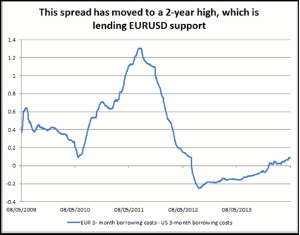The biggest theme in the FX market right now is the weakness in the dollar, says Kathleen Brooks of Forex.com.
The greenback is defying better-than-expected US economic data (the upside payrolls surprise last Friday), as well as the Fed's tapering program. So what is driving this weakness and can it last?
1. The Yield Effect
The 10-year Treasury yield has been trading in a range between 2.6 % and 2.8% since the end of January and currently it is testing the air below the bottom of the range around 2.59%. The Treasury yield has an indirect effect on dollar weakness, when yields are muted it reduces the cost of borrowing dollars, which can weigh on the value of USD. For example, the cost of borrowing USD for three months (according to ICE Libor rates) fell on Wednesday to its lowest level since records began at 0.2239%, which is a major drag on the buck. This has pushed the spread between EUR three-month borrowing costs and USD three-month borrowing costs to a two-year high (see the chart below), the spread with GBP borrowing costs and USD borrowing costs has also widened to its highest level since July 2012.
2. Low Volatility
We have mentioned in previous posts that volatility has been extremely low in financial markets. The VIX index (Wall Street's fear gauge) is close to the bottom of its recent range. Added to this, EUR/USD volatility remains close to a seven-year low. How does this impact the USD? When market volatility is low, it tends to favor current trends, thus the USD can stay depressed for longer than you may expect, along with Treasury yields, etc.
3. The US Loses the Limelight
The problem for the US is that economic data has not been consistent—think last week's weak GDP vs. strong payroll reports. At the same time, other regions are starting to shine. The OECD revised down its 2014 US GDP growth outlook, while at the same time revising higher its outlook for the UK and the Eurozone. The UK is now expected to have the fastest growth in the G7. Thus, the US has been nudged out of the limelight, which is weighing on the USD. We expect the US to play catch up in the second half of this year, but for now the market is going where the growth is, and right now the market seems skeptical of the US, preferring the Eurozone and the UK.
Conclusion:
Overall, this is a perfect storm for the buck right now: data is not consistent to instill confidence in the US recovery story; yields remain extremely low, which is allowing other currencies to make headway against the buck, and low volatility is muting the prospect of a near-term change in trend.
But don't expect this period of low volatility to continue. If history has taught us anything, periods of low volatility often end with a bang, and things may not be any different this time. If volatility does start to rise then dollar bears should beware. The long EUR/USD-long GBP/USD trade is starting to look a touch over-crowded, so if volatility spikes there could be a rush for the exits, which may mark the turning point for the greenback.
By Kathleen Brooks, UK and EMEA Research Director, Forex.com






















